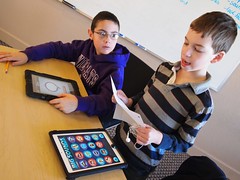 |
| by flickingerbrad, on Flickr |
Out with Large Books, in with a Small Tablet?
Oftentimes students look at the thick textbooks they are given at the beginning of the school year and feel overwhelmed by the amount of material they will have to read and learn. However, when these tomes are replaced by a sleek, modern and small tablet, some educators have found students are much more excited about the school year as their workload seems more manageable.
California middle school teacher, Jeannetta Mitchell explains to KQED that she has experienced this exact phenomenon in her algebra class. According to Mitchell, when students are presented with iPads instead of textbooks, “They believe they're going to learn what they have to form it because they don't see the whole book. They see bits of information as it's presented.” Mitchell also liked that the tablet helps her students learn how to arrive at answers by providing a step by step guide to solving math problems, as opposed to a textbook that simply provides answers in the back of the book.
Innovative Teaching Methods
 |
| by flickingerbrad, on Flickr |
Educators can also utilize tablets to create interesting power point presentations. The best part about using tablets to create a presentation is that the teacher can make changes during the presentation and add the student's ideas using the stylus to create a personalized and dynamic presentation.
Supplemental Materials Provide Additional Insights
Besides simply producing textbooks, publishers are now also creating supplemental materials for tablets to accompany the books. For example, Pearson offers assessment and gaming apps to go along with their history textbooks. Virginia students are using these tools as part of a pilot program to determine if they are effective or not. Overall the students and teachers involved in the pilot program want to continue, but the transition has not been without growing pains. Teachers cite time spent learning to use the device and choose appropriate content as some of the issues that need to be addressed.
However, overall the teachers are optimistic about incorporating tablets into their classrooms. Math teachers have found apps that help teach students fractions and decimals, while other teachers feel that the supplemental material that can be accessed in addition to the basic textbooks are especially beneficial for students.
Tablets are a relatively new technology, but are gaining popularity very quickly in the classroom. Not only do tablets have the potential to change the way classrooms are run and make learning more exciting, but their versatility and convenience also make them an effective educational tool.
This is a guest post by Marina Salsbury. Marina planned on becoming a teacher since high school, but found her way instead into online writing after college. She writes around the Web about everything from education to exercise.